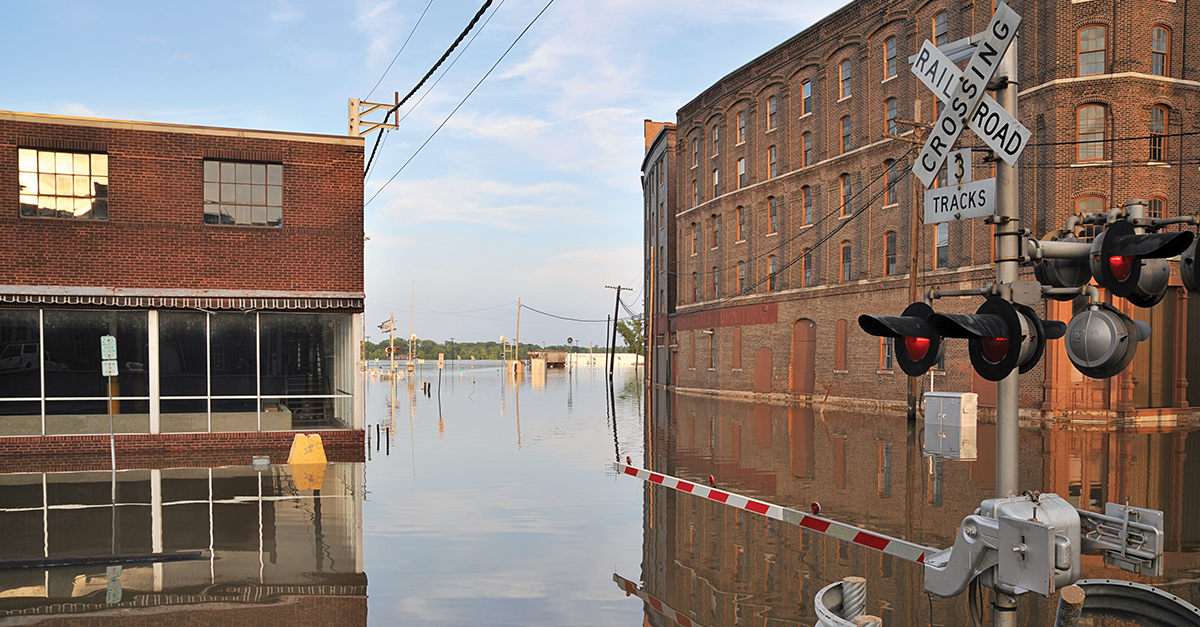Facility managers wear more hats during tornadoes, hurricanes, and other natural disasters. They are responsible for keeping customers and employees safe and protecting assets. Facility managers must anticipate, avoid, or accommodate damage done by severe weather; think through the eventualities; and have a preparedness plan and a decisive course of action in place for when natural disasters strike.
According to meteorologists, the 2017 Atlantic hurricane season was among the top 10 most active on record, thanks to a stretch of long-lived, destructive hurricanes from mid-August through September. Now more than ever, it is vital for facility managers to not only prepare for natural disasters, but have a recovery plan in place that will protect workers and building occupants during and after recovery efforts.
To get your facility up and running (both safely and smoothly) after the next catastrophe, you and your team should implement the following 10 steps:
1. Determine Structural Safety
After a hurricane or major natural disaster, it’s important to perform a visual inspection of all building structures before allowing employees to enter. Look for damage to structural elements of the building that may have been weakened by standing water or debris removal. Emergency repairs of structural areas may be necessary to secure elements such as walls, ceilings, and roofs. If there is serious structural damage, contact local officials before entering and report downed power lines or gas leaks.
2. Inspect Tools Prior to Use
Examine tools and equipment to ensure they are in good condition before use. If using a ladder, ensure its placement location is steady and solid, and use tie-off procedures if adequate guardrails are not present. When in doubt about the ability to safely use a ladder, wait to perform work at heights until adequate lifts, scaffolding, and other necessary equipment is available.
If using gasoline, diesel generators, or compressors, ensure their placement allows for adequate venting of exhaust gases out of the work area to minimize creating carbon monoxide exposure.
If there is serious structural damage, contact local officials before entering and report downed power lines or gas leaks.
3. Assess Electrical Hazards
Since emergency service personnel may have shut off electrical and gas utilities during or after a major storm, ensure everyone is out of harm’s way before restoring utilities. When attempting to reconnect power, avoid the use of extension cords in wet areas; discard frayed or damaged electrical cords. Take extreme caution around downed power lines—especially those in standing water—until the local utility company verifies they have been de-energized.
4. Managing Power Outages
If power outages are expected, avoid excessive opening and closing of freezers and refrigerators. Most refrigerators can maintain their temperature for up to four hours if the doors remain closed, and a freezer in good condition may maintain its temperature for up to 24 hours if unopened.
If refrigerator temperatures rise above 40 degrees Fahrenheit, throw out all perishable foods, such as milk and meats. These foods can grow harmful bacteria, putting people at risk for foodborne illness. Use a calibrated thermometer to test the temperature of foods and discard any items that have been above 41 degrees Fahrenheit for more than two hours. If power is expected to be out for an extended time, dry ice can help keep refrigeration temperatures at or below 41 degrees Fahrenheit; however, be cautious when using dry ice, as it can produce dangerous carbon dioxide gas in closed areas.
5. Clear Standing and Moving Water
The next step is to survey exterior areas for standing water, including landscaping, parking lots, and the roof of your building. Standing or moving water may have weakened structural areas or moved materials, creating a potential collapse or enclosure hazard. It’s important to use caution when entering moving or standing water, and to wear nonskid footwear to avoid slips and falls.
Be aware that floodwaters may contain human or animal waste products, as well as industrial or agricultural chemicals and petroleum products. Standing water with organic waste materials or chemicals may also generate an unusual atmospheric hazard where you might not normally expect one to exist.
6. Generate Power
If your facility loses power, tractor-trailers with large, mobile generators can be hooked into the electrical system to restore power. Generators are useful, but they also present certain risks, including fire or damage to electrical equipment. Make sure to keep the generator dry, as short circuits may occur in wet conditions, which can cause a generator fire. It’s also important to not “back feed” power by plugging the generator into a wall outlet. Back feeding will put you and others at serious risk as the utility transformer can increase low voltage from the generator to thousands of volts.
Proper ventilation is also critical to reduce the risk of carbon monoxide (CO) poisoning from a generator’s engine exhaust. CO poisoning is a common danger that can cause death. This is particularly true when the fuel is not burned completely. Never use generators indoors or outside near windows, vents, or air intakes that could allow CO to come indoors. It’s also smart to buy a detector to warn of rising CO levels.
7. Decontaminate Water Supply
If water is contaminated or a boil advisory is in effect, use bottled water for drinking and handwashing. If water has been contaminated, do not use any ice from ice machines or soda fountains. Once water service is restored and before using the machine, discard the first cycle of ice, then clean and sanitize ice bins after flushing the ice machine system.
Only use a dishwasher if 180 degree Fahrenheit or hotter rinse water is available. In the absence of a usable dish machine, use a three-compartment sink to wash wares with boiled water.
8. Disease Prevention and First Aid
After a major storm there is a significant potential for disease from debris, waste, and standing and contaminated water. First and foremost, make first aid kits accessible and contact medical professionals if injuries occur. Extra care should be taken in protecting broken skin—such as cuts or scrapes—to prevent disease transmission.
Humid, moist areas are prime breeding ground for mold and fungus growth. The sooner that debris can be removed and the space dried, the less chance of excessive mold growth.
9. Resolve Pest Issues
Flooding, rains, and winds associated with hurricanes can also create issues. Many pests are attracted to moisture and may gravitate to waterlogged facilities following a storm. Even minor flooding may displace pests and create pest issues unseen before a storm. All workers should use insect repellent containing DEET.
Post-flooding circumstances may also create a risk of snake and other reptile bites from animals trapped in structures during flooding. Flood-displaced rats may bring disease exposure and use of rat and snake bait stations is recommended.
Certain species of birds are susceptible to West Nile virus. By reporting dead birds to your local health authority, you may help prevent the spread of this dangerous mosquito-borne disease.
10. Report Losses
Provide your insurance provider with a general description of the damage and a list of damaged items. Keep damaged items or portions of them until the claim adjuster has visited. Also consider photographing or videotaping the damage to document your claim.




